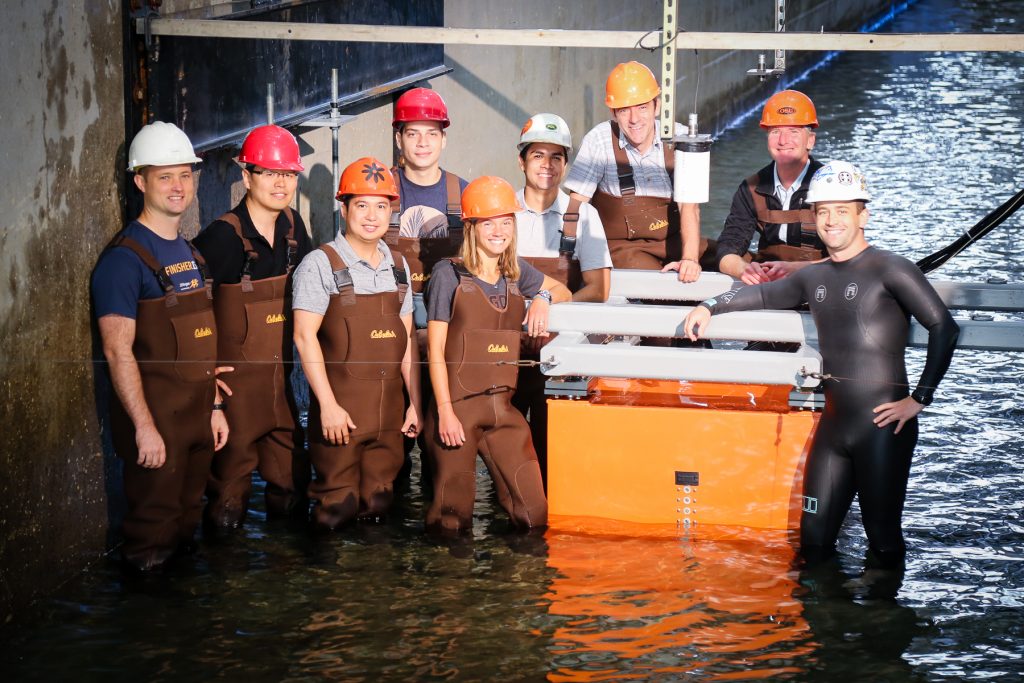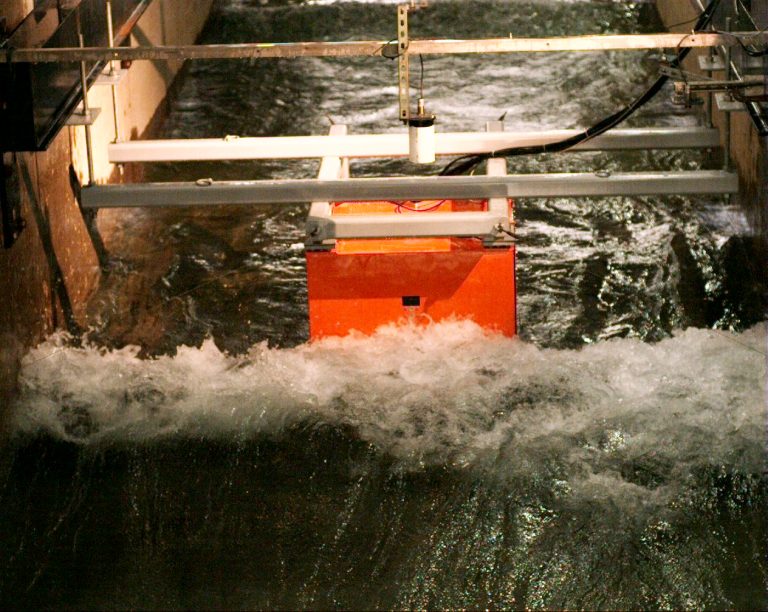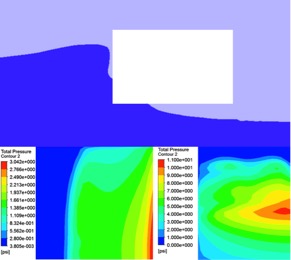
Researchers from Oregon State University and Colorado State University are conducting benchmark laboratory and numerical experiments to improve the resilience of coastal structures subject to hurricane waves and surge.
Principal investigator Dr. Daniel Cox and co-Principal Investigator Dr. John van de Lindt are concluding the first phase of a multiphase project titled “Experimental and Numerical Study to Improve Damage Due to Overland Wave and Surge Hazards on Near-Coast Structures.” The Coastal Resilience Center of Excellence (CRC) project includes three phases that will improve the estimation of damage based on overland surge and wave forces that can be used in risk-based design methodologies:
- Physical modeling to quantify wave forces on elevated coastal structures based on a variety of wave and surge conditions and develop predictive equations for horizontal and vertical wave forces.
- Develop fragility curves (statistical representation of vulnerability) for wave heights, pressures, or forces exceeding key damage thresholds.
- Illustrate risk-informed design methodologies that can improve the resilience of near-coast structures vulnerable to hurricane effects.
The research team is comprised of collaborators from Oregon State University (OSU) and Colorado State University (CSU), including CSU graduate student Trung Do, OSU graduate student Ben Hunter, Dr. Pedro Lomonaco (OSU), Tim Maddux (OSU), OSU graduate student Hyoungsu Park, OSU graduate student William Short and OSU graduate student Tori Tomiczek. This summer the project involved DHS-sponsored graduate student Kevin Cueto and undergraduate student Diego Delgado from the University of Puerto Rico-Mayaguez (UPRM) during the summer as part of the CRC SUMmer Research EXperience (SUMREX) program. Through this program, students from CRC education partners, including UPRM, visit PIs from research partners to be involved in research projects and gain experience.
Protecting our coastlines

In the United States alone, hurricanes cause economic damages reaching $35.8 billion per year, according to William Nordhaus of Yale University. With almost 50 percent of the U.S. population living within 50 miles of a coastline, fully understanding the hazards associated with hurricanes is critical for preventing damage in coastal communities.The goal of this project is to improve existing software used by FEMA and other federal and state agencies to estimate hurricane damage and loss.
“Our goal is to develop fragility curves that can be used to improve infrastructure resilience,” Dr. Cox said. “By improving the predictions of damage and loss, we will be better positioned to anticipate hazards and manage cascading consequences and interactions between infrastructure and hazards. This will allow us to make design decisions that ensure a given hurricane will have less of an impact on a coastal community.”
A benchmark dataset
The first phase of this project, which ran from late June to mid-September, consisted of a hydraulic testing program that collected benchmark data to measure both horizontal and vertical wave forces and pressures on structures. Experiments were conducted in Oregon State University’s Long Wave Flume, which is 341 feet long by nearly 12 feet wide; imagine waves traveling along a one-lane road as long as a football field. Wave heights and structural dimensions were chosen based on a simulation of Hurricane Ike (2008) impacting an elevated structure on the Bolivar Peninsula near the Houston/Galveston region in Texas at a 1:10 scale.
Hurricane waves were imposed on a constant surge level of 0.4 meters (representing a 4-meter storm surge). Wave gauges were used to measure water surface elevations in the flume, while pressure sensors and load cells were installed on the structure to measure pressures and forces on the specimen. Results are being analyzed this fall to characterize pressure distributions caused by waves and to modify existing design equations to predict the horizontal and vertical forces due to waves.

Current building design is not intended to be impacted by waves, but rather to avoid them entirely,” Dr. van de Lindt said. “With this new approach to design, we can provide designers a mechanism to consider the tradeoffs between designing for waves and increasing elevation; it’s a financial tradeoff.”
Preliminary results indicate that the type of wave impacting the structure (nonbreaking, breaking or broken) result in varied pressure distributions and forces in the vertical and horizontal directions. This means that wave conditions of all types must be accounted for in the design of resilient structures. Results will be further analyzed to develop probabilities for significant forces caused by known wave climates to exceed structures’ thresholds.
Numerical modeling
Experimental data will be vital in validating numerical models. Using the boundary conditions from experiments, team members Hyoungsu Park and Trung Do are modeling complex wave-structure interactions using the computational fluid dynamics (CFD) computer models OpenFOAM® and ANSYS Fluent®. Preliminary results show promising agreement between experimental and modeled wave profiles, pressures and horizontal and vertical forces.
Next steps

After determining key relationships between wave height, wave-breaking condition, and resulting forces from experimental data, researchers will develop conditional probabilities, known as fragilities, for exceeding key thresholds associated with damage levels in Hazus-MH, a multi-hazard software used by FEMA. Using these fragilities, risk-informed design methodologies will be demonstrated for engineering practice on several archetype buildings. The expertise of end-users Bill Coulbourne (Coulbourne Consulting; formerly Applied Technology Council) and Chris Jones (consulting engineer, coastal engineering) will be essential in developing efficient and accurate design methodologies to improve the safety of building design standards. Doug Bausch will also serve as a collaborator for integrating project results into FEMA’s Hazus-MH and a consultant for determining the next steps for improving retrofit designs and coastal building codes. Ultimately, results from this project may help to improve future revisions of ASCE-7 Flood Load Chapter 5 and FEMA’s Coastal Construction Manual, which defines principles and practices of planning, constructing, and maintaining residential buildings in coastal areas.
The NIST-funded Center for Risk-Based Community Resilience Planning, where Dr. van de Lindt is co-director, uses fragilities for archetypical buildings for many different hazards, there is a lack of surge and wave fragility information available. The fragilities developed in this CRC project will eventually be adopted for us in IN-CORE, the computational platform being developed by the NIST Center, Dr. van de Lindt said.
“One major goal of that work is to provide a methodology to consider alternative mitigation and adaption strategies,” Dr. van de Lindt said. “The design approach developed here can be examined as one alternative for coastal communities.”
View a clip of the lab in action at http://unc.live/2dqwf8F.
